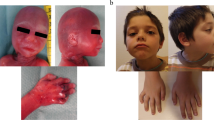Abstract
Saethre–Chotzen syndrome is a very rare autosomal dominant congenital disorder characterized by craniosynostosis and acrocephalosyndactyly. It is caused by a mutation in TWIST1, located on chromosome 7p21. A shortage of functional TWIST1 protein affects the development and maturation of cells in the skull, face, and limbs. The patient described in this report displayed craniofacial features classic for Saethre–Chotzen syndrome, including craniosynostosis, low-set ears, small pinna with prominent crura, a high-arched palate, and a simian crease on the left hand. He did not have the limb anomalies commonly seen in patients with Saethre–Chotzen syndrome, and the results of conventional chromosome analysis were normal. However, results of a microarray-based comparative genomic hybridization (array CGH) study confirmed the karyotype of 46,XY.7p21.1p15.3(15,957,375-20,331,837)x1, a region that includes TWIST1. Subsequent fluorescent in situ hybridization analysis confirmed this result. No other chromosome was involved in the rearrangement. This case illustrates the important contribution of array CGH to the identification of TWIST microdeletions, even in a patient not showing the phenotype typical of Saethre–Chotzen syndrome.


Similar content being viewed by others
References
Cai J, Goodman BK, Patel AS, Mulliken JB, Van Maldergem L, Hoganson GE, Paznekas WA, Ben-Neriah Z, Sheffer R, Cunningham ML (2003) Increased risk for developmental delay in Saethre–Chotzen syndrome is associated with TWIST deletions: an improved strategy for TWIST mutation screening. Hum Genet 114:68–76
Peña WA, Slavotinek A, Oberoi S (2010) Saethre–Chotzen syndrome: a case report. Cleft Palate Craniofac J 47:318–321
de Heer IM, de Klein A, van den Ouweland AM, Vermeij-Keers C, Wouters CH, Vaandrager JM, Hovius SE, Hoogeboom JM (2005) Clinical and genetic analysis of patients with Saethre–Chotzen syndrome. Plast Reconstr Surg 115:1894–1902
Friedman J, Hanson JW, Graham CB, Smith DW (1977) Saethre–Chotzen syndrome: a broad and variable pattern of skeletal malformations. J Pediatr 91:929–933
Kress W, Schropp C, Lieb G, Petersen B, Büsse-Ratzka M, Kunz J, Reinhart E, Schäfer W-D, Sold J, Hoppe F (2005) Saethre–Chotzen syndrome caused by TWIST 1 gene mutations: functional differentiation from Muenke coronal synostosis syndrome. Eur J Med Genet 14:39–48
Howard TD, Paznekas WA, Green ED, Chiang LC, Ma N, De Luna RIO, Delgado CG, Gonzalez-Ramos M, Kline AD, Jabs EW (1997) Mutations in TWIST, a basic helix–loop–helix transcription factor, in Saethre–Chotzen syndrome. Nat Genet 15:36–41
Reardon W, Winter RM (1994) Saethre–Chotzen syndrome. J Med Genet 31:393
El Ghouzzi V, Le Merrer M, Perrin-Schmitt F, Lajeunie E, Benit P, Renier D, Bourgeois P, Bolcato-Bellemin A-L, Munnich A, Bonaventure J (1997) Mutations of the TWIST gene in the Saethre–Chotzen syndrome. Nat Genet 15:42–46
Gripp KW, Zackai EH, Stolle CA (2000) Mutations in the human TWIST gene. Hum Mutat 15:150–155
De Gregori M, Ciccone R, Magini P, Pramparo T, Gimelli S, Messa J, Novara F, Vetro A, Rossi E, Maraschio P (2007) Cryptic deletions are a common finding in “balanced” reciprocal and complex chromosome rearrangements: a study of 59 patients. J Med Genet 44:750–762
Gribble S, Prigmore E, Burford D, Porter K, Ng BL, Douglas E, Fiegler H, Carr P, Kalaitzopoulos D, Clegg S (2005) The complex nature of constitutional de novo apparently balanced translocations in patients presenting with abnormal phenotypes. J Med Genet 42:8–16
Hoffer M, Hilhorst-Hofstee Y, Knijnenburg J, Hansson K-B, Engelberts A, Laan L, Bakker E, Rosenberg C (2007) A 6Mb deletion in band 2q22 due to a complex chromosome rearrangement associated with severe psychomotor retardation, microcephaly and distinctive dysmorphic facial features. Eur J Med Genet 50:149–154
Schluth-Bolard C, Till M, Labalme A, Rey C, Banquart E, Fautrelle A, Martin-Denavit T, Le Lorc'h M, Romana SP, Lazar V (2008) TWIST microdeletion identified by array CGH in a patient presenting Saethre–Chotzen phenotype and a complex rearrangement involving chromosomes 2 and 7. Eur J Med Genet 51:156–164
Conflict of interest
The authors declare that they have no conflict of interest.
Author information
Authors and Affiliations
Corresponding author
Rights and permissions
About this article
Cite this article
Cho, E., Yang, T.H., Shin, ES. et al. Saethre–Chotzen syndrome with an atypical phenotype: identification of TWIST microdeletion by array CGH. Childs Nerv Syst 29, 2101–2104 (2013). https://doi.org/10.1007/s00381-013-2235-0
Received:
Accepted:
Published:
Issue Date:
DOI: https://doi.org/10.1007/s00381-013-2235-0




